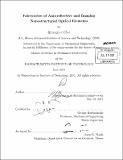Fabrication of anti-reflective and imaging nanostructured optical elements
Author(s)
Choi, Hyungryul
DownloadFull printable version (8.634Mb)
Other Contributors
Massachusetts Institute of Technology. Department of Mechanical Engineering.
Advisor
George Barbastathis.
Terms of use
Metadata
Show full item recordAbstract
Moth eyes minimize reflection over a broad band of angles and colors and lotus leaves minimize wetting over a broad range of breakthrough pressures by virtue of subwavelength structures patterned on their respective surfaces; similar examples of organisms exploiting geometry to attain properties unavailable in bulk materials are abundant in nature. These instances have inspired applications to man-made structures, collectively known as functional materials: for example, self-cleaning/anti-fogging surfaces, and solar cells with increased efficiency. I fabricated a functional surface where both wetting and reflectivity are controlled by geometry. Using a periodic array of subwavelength-sized high aspect ratio cones, patterned on glass and coated with optimized surfactants, I have experimentally shown that we can significantly enhance transmission from the surfaces of a glass slab, and at the same time make the surfaces either superhydrophobic or superhydrophilic, depending on the applications, such as antifogging and self-cleaning glass. Novel lithographic techniques result in high patterning accuracy over large surface areas, and is easily adaptable to nanoimprinting for future mass replication. In addition, an all-dielectric subwavelength-patterned Luneburg lens was fabricated for operation at free-space wavelength of A =1.55 um.
Description
Thesis (S.M.)--Massachusetts Institute of Technology, Dept. of Mechanical Engineering, 2011. Cataloged from PDF version of thesis. Includes bibliographical references (p. 69-73).
Date issued
2011Department
Massachusetts Institute of Technology. Department of Mechanical EngineeringPublisher
Massachusetts Institute of Technology
Keywords
Mechanical Engineering.